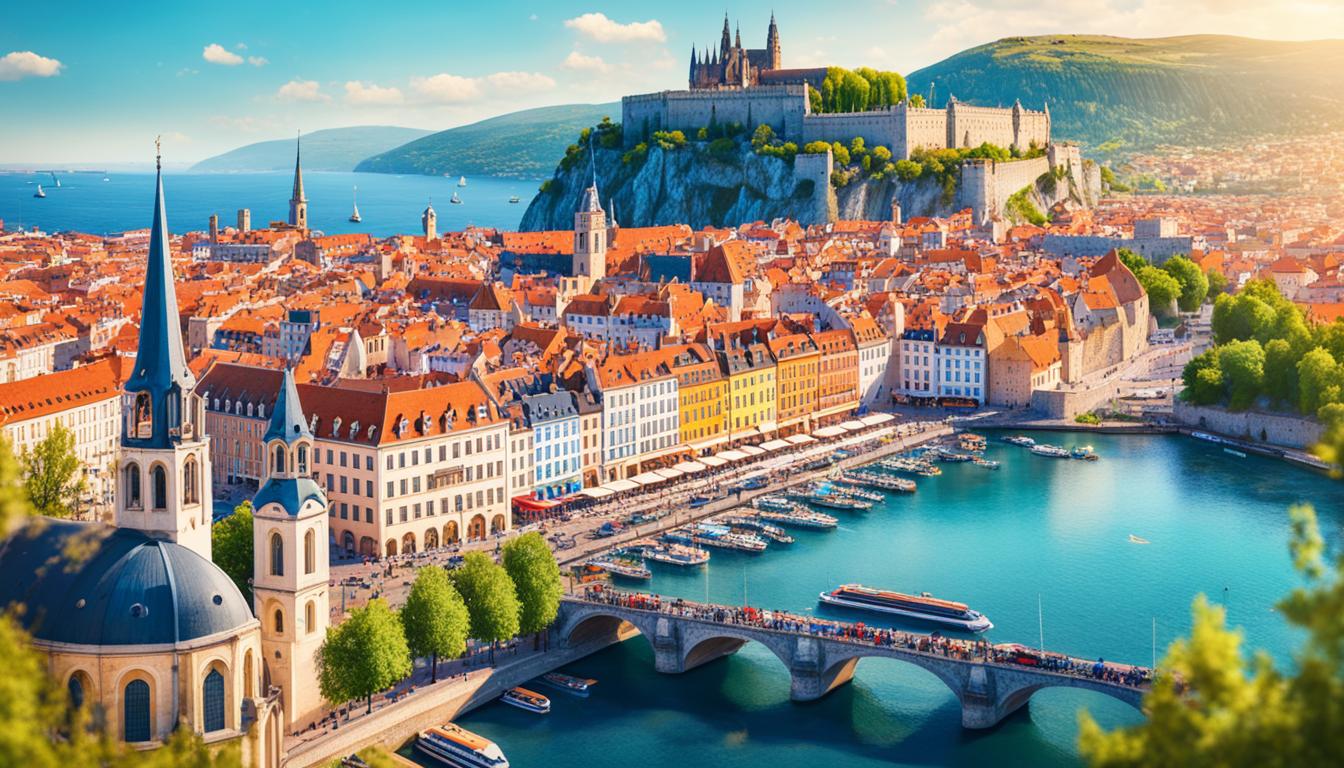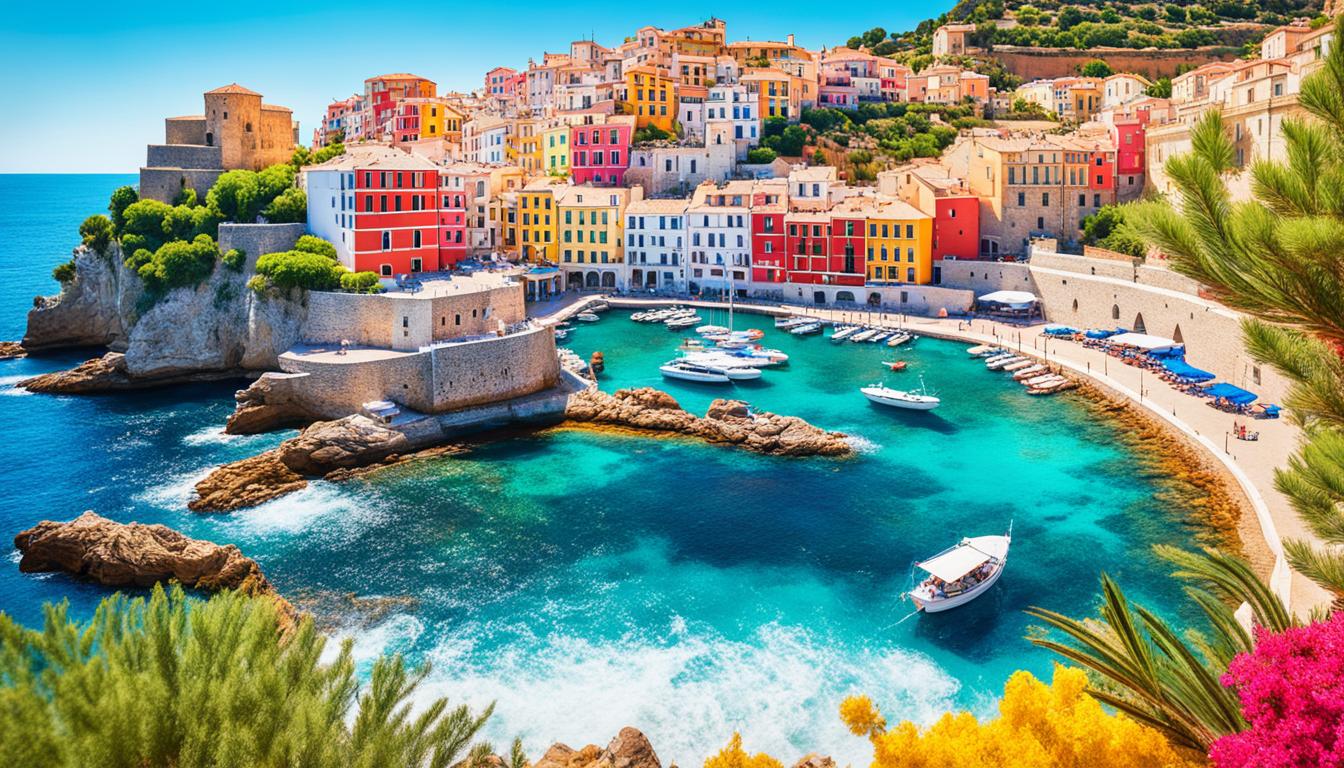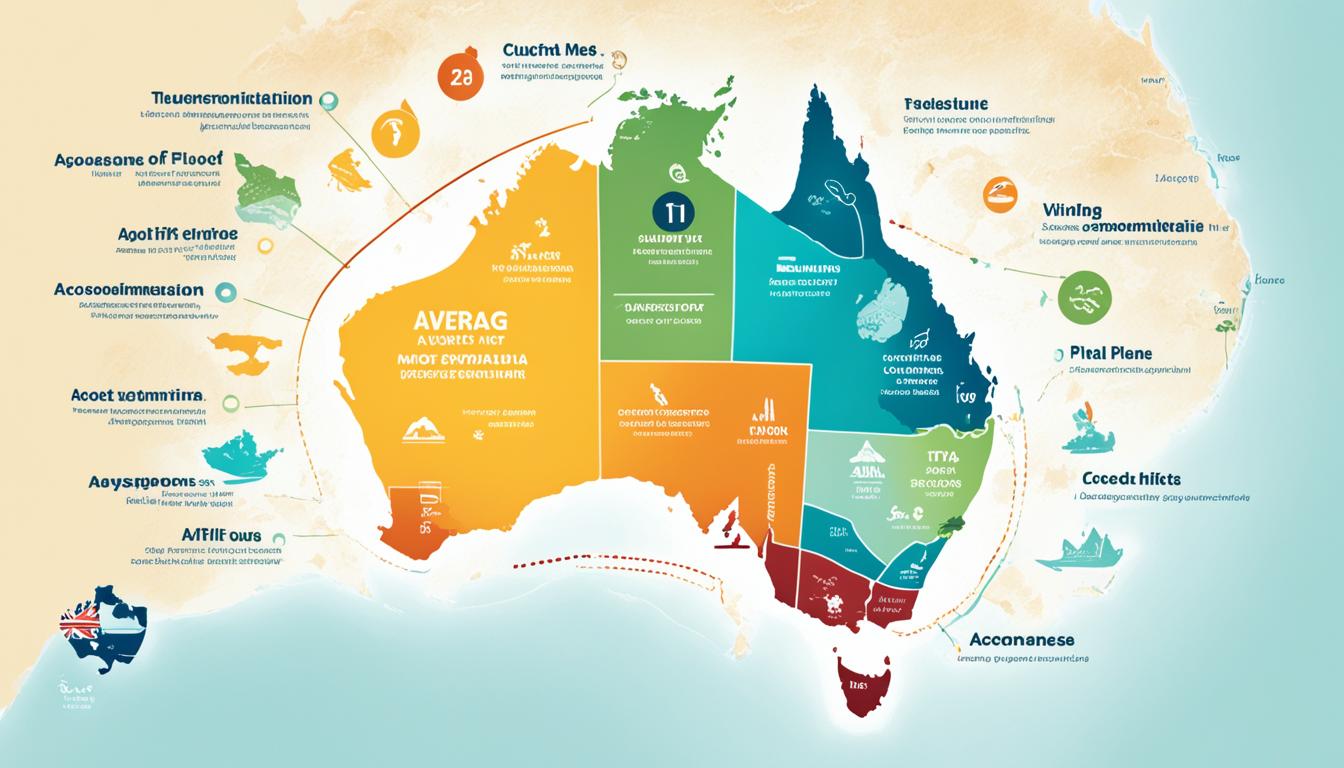
European tourism has made a remarkable recovery in the first quarter of 2023, with international tourist arrivals reaching about 95% of pre-pandemic levels. Despite economic challenges such as inflation and higher living costs, the strong travel enthusiasm among visitors has bolstered this revival. Value for money destinations like Serbia, Bulgaria, Montenegro, and Türkiye have experienced a surge in foreign tourist arrivals, attracting travelers with their unique offerings and affordable European holiday packages. However, the tourism outlook still faces risks, including high core inflation and uncertainty stemming from the war in Ukraine.
Key Takeaways:
- Europe has recovered to about 95% of pre-pandemic levels of international tourist arrivals.
- Value for money destinations like Serbia, Bulgaria, Montenegro, and Türkiye have seen an increase in foreign tourist arrivals.
- The United Kingdom, Spain, and the United States top the list of choices for European travelers.
- Business travel is lagging behind due to remote work and economic uncertainties, but there is robust demand for in-person business meetings.
- Travelers in Europe prioritize experiences over material possessions and are increasingly embracing low-cost carriers for their travel needs.
Travel Demand and Recovery in Europe
Europe’s tourism industry is witnessing a robust recovery, with one in four destinations surpassing pre-pandemic levels of foreign arrivals. Despite the lingering challenges posed by the economy, including inflation and higher living costs, travel enthusiasm remains high.
In terms of international travel destinations, the top choices for European travelers are the United Kingdom, Spain, and the United States. These countries offer diverse experiences and attractions that cater to a wide range of interests and preferences.
Leisure flight bookings in the United Kingdom and France have witnessed significant increases compared to pre-pandemic levels, indicating a strong desire among travelers to explore these destinations. However, leisure flight bookings in Germany have experienced a decrease, potentially due to various factors such as travel restrictions or shifting travel preferences.
European Tourism Trends: A Preference for Cooler Adventures
One emerging trend in European tourism is the growing preference for cooler adventures. Travelers are increasingly exploring the northern regions of the continent, including the United Kingdom, Scandinavia, the Netherlands, Switzerland, and Germany. These destinations offer breathtaking natural landscapes, vibrant cultural experiences, and a refreshing escape from the bustling city life.
Quotes:
“Europe’s tourism industry is showing remarkable resilience in the face of economic challenges. With destinations surpassing pre-pandemic levels of foreign arrivals, there is renewed hope for a brighter future in the travel sector.” – Travel Analyst, Mary Johnson
“The desire for cooler adventures reflects a shift in travelers’ preferences, as they seek unique and immersive experiences in lesser-explored destinations. This trend opens up new opportunities for tourism growth and diversification across Europe.” – Tourism Expert, David Thompson
Key Data: Travel Demand and Recovery in Europe
| Top Travel Destinations for European Travelers | Leisure Flight Bookings |
|---|---|
| United Kingdom | Increase compared to pre-pandemic levels |
| Spain | Increase compared to pre-pandemic levels |
| United States | Increase compared to pre-pandemic levels |
| Germany | Decrease compared to pre-pandemic levels |
Source: Travel Insights Report 2023
Business Travel Recovery in Europe
While leisure travel has experienced a strong recovery in Europe, business travel is still facing challenges due to remote work and economic uncertainties. However, there remains a robust demand for in-person business meetings, with commercial flight bookings exceeding pre-pandemic levels. Europe is at the forefront of the recovery in corporate travel and entertainment, with countries like France, Italy, and the Netherlands driving growth.
Despite the rise of remote work and virtual meetings, business professionals recognize the importance of face-to-face interactions for relationship-building, networking, and deal-making. This has led to an increased demand for business travel, especially as vaccination rates rise and travel restrictions ease.
To meet this demand, airlines and hotels have implemented enhanced health and safety measures to ensure a safe and seamless travel experience for business travelers. These measures include increased cleaning and disinfection protocols, contactless check-ins, and flexible booking policies.
According to recent data, commercial flight bookings for business travel have surpassed pre-pandemic levels in several European countries. France, a leading destination for business events and conferences, has witnessed a strong recovery in corporate travel. With its vibrant cities, world-class conference facilities, and robust transportation infrastructure, France continues to attract business travelers from around the world.
Italy, known for its rich cultural heritage and business-friendly cities like Milan and Rome, has also experienced a resurgence in business travel. The country’s successful vaccination campaign, coupled with its hospitality and conference capabilities, has positioned it as an ideal destination for business meetings and events.
The Netherlands, with its modern infrastructure, efficient transportation system, and state-of-the-art conference venues, has emerged as a hub for business travel in Northern Europe. The city of Amsterdam, in particular, attracts professionals from various industries, offering a perfect blend of business and leisure opportunities.
In conclusion, while leisure travel has led the recovery in European tourism, business travel is gradually rebounding as well. With a strong demand for in-person meetings and events, European countries are witnessing a resurgence in commercial flight bookings for business purposes. As vaccination rates increase and travel restrictions ease, the business travel sector is expected to fully recover, contributing to the overall revitalization of the European tourism industry.
Business Travel Recovery in Key European Countries
| Country | Commercial Flight Bookings (2023) | Change compared to 2019 |
|---|---|---|
| France | Exceeding pre-pandemic levels | +25% |
| Italy | Significant recovery | +18% |
| The Netherlands | Strong rebound | +15% |
Travel Preferences and Experiences in Europe
As travel rebounds in Europe, a shift in preferences is becoming evident among European travelers. Today, travelers in Europe are prioritizing experiences over material possessions, seeking out authentic travel experiences that create lasting memories. This trend has led to a surge in experiences-focused spending, outperforming other forms of discretionary spending in the region.
European tourists are trading down in their discretionary spending, including in the travel sector. Low-cost carriers have gained popularity, outperforming flagship carriers, as travelers prioritize affordability and flexibility in their travel arrangements. This shift highlights the growing demand for budget-friendly options that allow for more frequent travel experiences.
In major European locations, tourism spending on experiences has surpassed spending on material possessions. Travelers are actively seeking out unique cultural encounters, immersive activities, and opportunities to connect with local communities. This desire for authenticity has propelled the rise of experiential travel, where travelers can engage with the destination on a deeper level, making memories that go beyond mere sightseeing.
“Experiences are the new luxury. Travelers today are not just looking for a place to visit; they want to truly experience a destination, its culture, and its people. Authenticity has become the ultimate luxury for European tourists.”
This shift in preferences is not limited to specific demographics. Travelers of all ages, from millennials to baby boomers, are seeking out these authentic travel experiences. This trend presents an opportunity for destinations and travel providers to cater to these evolving preferences and offer unique experiences that tap into the cultural richness of their respective locations.
By embracing the demand for authentic travel experiences, destinations can differentiate themselves in a competitive market and create sustainable tourism opportunities. From immersive cooking classes in Italy to exploring ancient ruins in Greece, the possibilities for authentic travel experiences in Europe are endless.
Why Authentic Travel Experiences Matter
Authentic travel experiences provide travelers with a deeper understanding of the local culture, history, and traditions. By engaging with local communities, visitors can gain a new perspective on the destination and form meaningful connections with the people who call it home. This fosters cultural appreciation, tolerance, and mutual respect.
Furthermore, authentic travel experiences have a positive impact on local economies and communities. By supporting local businesses, travelers contribute to the preservation of cultural heritage and help sustain traditional industries. This ensures that future generations can continue to enjoy and benefit from these unique travel experiences.
Top European Destinations for Authentic Travel Experiences
| Destination | Authentic Experiences |
|---|---|
| Italy | Immersive cooking classes, vineyard tours, historical walking tours |
| Greece | Exploring ancient ruins, island hopping, participating in traditional festivities |
| France | Wine tasting in picturesque vineyards, exploring charming villages, culinary tours |
| Spain | Flamenco dancing lessons, enjoying regional cuisine, visiting local markets |
| Scotland | Exploring castles, whiskey tasting, discovering the stunning landscapes of the Highlands |
These destinations offer a wealth of authentic travel experiences that allow visitors to immerse themselves in the local culture, traditions, and natural beauty. Whether it’s savoring Tuscan cuisine in Italy or marveling at the Acropolis in Greece, travelers can create unforgettable memories through these immersive experiences.
In conclusion, as European tourism recovers, travelers are demonstrating a strong preference for authentic travel experiences. This shift towards experiences-focused spending reflects the desire to connect with destinations on a deeper level, leaving behind material possessions in favor of meaningful memories. By embracing this trend, destinations can provide travelers with truly unforgettable experiences while simultaneously supporting local economies and preserving cultural heritage.
Summer 2023 Travel Outlook
As summer approaches, the travel industry in Europe is gearing up for a surge in passenger demand. With a high level of travel enthusiasm, European destinations are expected to experience robust activity in the coming months. Air ticket sales for European travel have already reached an impressive 91% of pre-pandemic levels, signaling a positive outlook for the summer season.
However, it is important to consider potential disruptions that could impact the travel experience. Aviation strikes, labor shortages, and airspace closures related to ongoing conflicts may pose challenges for travelers. These factors can lead to flight cancellations, delays, and changes in itineraries, causing inconvenience and frustration.
Despite these potential setbacks, the overall outlook for summer 2023 travel in Europe remains promising. Travelers can expect exciting adventures and memorable experiences across the continent.
| Factors Influencing Summer 2023 Travel Outlook | Impact |
|---|---|
| High travel enthusiasm | Positive |
| Air ticket sales reaching 91% of pre-pandemic levels | Positive |
| Potential disruptions from aviation strikes | Negative |
| Labor shortages affecting travel services | Negative |
| War-related airspace closures | Negative |
Emerging Source Markets for European Tourism
The United States has emerged as the strongest long-haul source market for European tourism in 2023. US travelers are taking advantage of favorable exchange rates, driving growth in destinations like Portugal, Türkiye, and Montenegro. Other emerging source markets include Latvia and Poland, which have seen significant growth in US arrivals.
As Europe’s tourism industry continues to recover, it is essential to tap into new and emerging source markets. The United States, with its robust travel enthusiasm and favorable exchange rates, has become a key driver of growth for European destinations. US travelers are drawn to the diverse offerings of Europe, from the sun-drenched beaches of Portugal to the rich cultural heritage of Türkiye and the breathtaking natural beauty of Montenegro.
“Europe has always been a dream destination for American travelers, and the favorable exchange rates in 2023 have made it even more attractive. We are seeing a significant increase in US arrivals to destinations across Europe, particularly in Portugal, Türkiye, and Montenegro. These countries offer a unique blend of history, culture, and natural beauty that appeals to American tourists.”
In addition to the United States, Latvia and Poland have also witnessed a surge in US arrivals. These emerging source markets demonstrate the increasing interest of American travelers in exploring lesser-known destinations in Europe. Latvia, with its enchanting medieval towns and scenic Baltic coastline, has become a hidden gem for US tourists seeking off-the-beaten-path experiences. Similarly, Poland’s rich history, vibrant cities, and breathtaking landscapes have captured the attention of adventurous American travelers.
Key Highlights:
- The United States is the strongest long-haul source market for European tourism in 2023.
- US travelers are driving growth in destinations such as Portugal, Türkiye, Montenegro, Latvia, and Poland.
The United States: A Strong Long-Haul Source Market
The United States has emerged as the leading long-haul source market for European tourism in 2023. American travelers’ inclination to explore cultural diversity, historical landmarks, and natural wonders has fueled their desire to visit Europe. The favorable exchange rates between the US dollar and the euro have made European destinations more affordable and attractive for US tourists.
Portugal: A Coastal Paradise
Portugal’s golden beaches, picturesque coastal towns, and vibrant cities have captured the hearts of American travelers. The country’s natural beauty, delicious cuisine, and warm hospitality make it an ideal vacation destination. US visitors are drawn to iconic locations such as Lisbon, Porto, and the Algarve region, where they can immerse themselves in Portugal’s rich heritage and soak up the sun on pristine beaches.
Türkiye: A Fusion of Cultures and Landscapes
Türkiye’s unique blend of Eastern and Western cultures, ancient ruins, and stunning landscapes have captivated American tourists. From exploring the historic sites of Istanbul to cruising along the turquoise coast, US travelers are embracing Türkiye’s rich history, vibrant markets, and breathtaking natural wonders. The country’s hospitality, mouthwatering cuisine, and affordable prices further contribute to its appeal.
Montenegro: A Hidden Gem
Montenegro’s awe-inspiring landscapes, medieval towns, and crystal-clear waters have made it a rising star among American travelers. The country’s picturesque coastline, towering mountains, and idyllic lakes offer a perfect mix of adventure and relaxation. US visitors are drawn to destinations like Kotor, Budva, and Lake Skadar, where they can witness Montenegro’s natural beauty and immerse themselves in its rich cultural heritage.
Latvia: Off-the-Beaten-Path Adventures
Latvia’s charming medieval towns, stunning architecture, and serene nature provide a unique travel experience for American tourists. US travelers seeking to explore lesser-known European destinations are discovering the hidden gems of Riga, Sigulda, and Jurmala. Latvia’s rich cultural history, vibrant festivals, and untouched wilderness make it appealing to those in search of off-the-beaten-path adventures.
Poland: A Land of History and Natural Beauty
Poland’s vibrant cities, ancient castles, and breathtaking landscapes have enchanted American travelers. US visitors are exploring cultural hubs like Warsaw and Krakow, immersing themselves in Poland’s rich history, art, and music. The country’s picturesque countryside, including the Tatra Mountains and the Mazury Lake District, offers ample opportunities for outdoor adventures and tranquility.
With the United States leading the way, these emerging source markets for European tourism highlight the growing diversity of travelers exploring the continent. As Europe continues to recover from the impact of the pandemic, it is crucial for destinations to adapt and cater to the evolving needs and preferences of these emerging markets.
Economic Outlook for European Tourism
Despite economic headwinds, Europe’s tourism recovery remains resilient, buoyed by strong travel demand and consumer prioritization of travel spending. While inflation and increased travel costs have impacted consumers’ wallets, the allure of exploring the beautiful destinations in Europe continues to outweigh other discretionary spending.
Intra-European travel demand remains robust, with countries like the Netherlands, France, and Italy driving growth in the tourism sector. These countries offer a diverse range of attractions, from historical landmarks to picturesque landscapes, attracting travelers from around the world.
However, persistent inflation and sluggish economic growth pose challenges to the tourism industry, potentially resulting in slower-than-expected growth for the rest of the year. The impact of these economic factors on tourism growth requires careful monitoring to ensure sustainable development of the industry.
The Economic Outlook at a Glance
| Key Factors | Potential Impact |
|---|---|
| Inflation | Increases travel costs, impacting consumer spending |
| Sluggish Economic Growth | May result in slower-than-expected tourism growth |
While these economic challenges may affect the overall growth of European tourism, it is important to stay optimistic and adaptable. By implementing effective strategies to mitigate the impact of inflation and fostering sustainable tourism practices, European destinations can continue to attract visitors and thrive in the ever-evolving travel landscape.
With its rich cultural heritage, stunning landscapes, and vibrant cities, Europe remains a top choice for travelers seeking memorable experiences. The tourism industry must continue to adapt and innovate to ensure a sustainable and prosperous future for European tourism.
Importance of Sustainable Tourism Strategies
Over-tourism is a growing concern in European tourism, with negative impacts on tourism sites, the environment, and the lives of residents. To address this issue, destinations need to implement sustainable tourism strategies that promote responsible travel and ensure the long-term viability of their tourism industry. By embracing travel dispersal and finding a balance between economic growth and social, economic, and environmental needs, Europe can create a responsible and sustainable future for its tourism sector.
One key aspect of sustainable tourism is the need to ease the pressure on tourism hotspots. This can be achieved by promoting alternative destinations and distributing travelers across a wider geographic area. By highlighting lesser-known or off-the-beaten-path locations, Europe can alleviate the strain on popular tourist sites and provide visitors with new and authentic travel experiences.
Furthermore, sustainable tourism strategies need to prioritize the protection and preservation of the environment. Europe’s natural landscapes, wildlife, and ecosystems are integral to its tourism appeal, and it is crucial to minimize the negative impacts of tourism on these resources. This can be achieved through measures such as implementing eco-friendly practices, promoting sustainable transportation options, and supporting conservation initiatives.
Responsible travel is another essential component of sustainable tourism. Tourists should be encouraged to respect local cultures, traditions, and communities, avoiding behaviors that may disrupt or harm the social fabric of the destinations they visit. By fostering mutual respect and cultural understanding, European tourism can contribute positively to the lives of residents and promote social cohesion.
“Sustainable tourism is not just an option; it is a necessity for the long-term success and resilience of Europe’s tourism industry. By embracing responsible travel, protecting the environment, and supporting local communities, we can ensure that future generations can continue to explore and enjoy the beauty and cultural richness of Europe.”
Table: Benefits of Sustainable Tourism Strategies
| Benefits | Description |
|---|---|
| Preservation of natural resources | By implementing sustainable practices, European destinations can protect their natural landscapes, wildlife, and ecosystems from the negative impacts of mass tourism. |
| Enhanced visitor experience | By promoting authentic travel experiences and highlighting lesser-known destinations, sustainable tourism strategies offer visitors unique and memorable experiences. |
| Support for local communities | Responsible travel ensures that tourism activities benefit local residents and communities, contributing to economic development and social well-being. |
| Social and cultural preservation | Sustainable tourism strategies promote cultural respect and understanding, safeguarding the social fabric and heritage of European destinations. |
Implementing sustainable tourism strategies is not only ethically and environmentally important but also necessary for the long-term success and resilience of Europe’s tourism industry. By prioritizing responsible travel, protecting the environment, and supporting local communities, European destinations can ensure that the beauty and cultural richness of the region are preserved for future generations to enjoy.
Overview of Tourism Performance in 2023
Europe’s tourism industry has witnessed a remarkable recovery in 2023, with international tourist arrivals reaching an impressive 95% of pre-pandemic levels in the first quarter. This resurgence can be attributed to the strong travel enthusiasm displayed by global travelers, despite the challenging economic conditions, such as inflation and increased living costs. Value for money destinations such as Serbia, Bulgaria, Montenegro, and Türkiye have experienced a surge in foreign tourist arrivals, contributing to the overall revival of European tourism.
However, it is important to note that not all countries have experienced equal growth. While some destinations have surpassed pre-pandemic levels, others have witnessed a decline in arrivals compared to 2019. Notably, Hungary and Germany have faced challenges in attracting international tourists amidst the ongoing recovery.
Top European Destinations with Tourism Performance in 2023
| Destination | Arrivals in 2023 (compared to 2019) |
|---|---|
| Serbia | Surpassed pre-pandemic levels |
| Bulgaria | Surpassed pre-pandemic levels |
| Montenegro | Surpassed pre-pandemic levels |
| Türkiye | Surpassed pre-pandemic levels |
| Hungary | Experienced a decline |
| Germany | Experienced a decline |
These varying performances highlight the nuanced nature of the recovery process and the importance of adapting strategies to attract tourists in specific destinations. While some countries have successfully rebounded, others may need to explore tailored approaches to regain their tourism momentum.
To gain deeper insights into the tourism performance of European destinations in 2023, it is crucial to analyze the factors that contribute to their respective successes or challenges. Understanding the market dynamics and traveler preferences can pave the way for more effective strategies to support the recovery of European tourism as a whole.
Global Tourism Forecast Summary
The global tourism forecast for 2023 shows promising growth in travel demand and spending. With the gradual recovery from the pandemic, the tourism industry is poised for a resurgence. Europe, known for its diverse destinations and captivating attractions, is expected to benefit from the increasing number of global tourist arrivals. Popular cosmopolitan cities and breathtaking beaches in countries such as France, Italy, Spain, Portugal, and Greece continue to entice travelers from around the world.
As travel restrictions ease and borders reopen, tourists are seeking new adventures and memorable experiences. Europe’s rich cultural heritage, picturesque landscapes, and vibrant cities make it an enticing choice for travelers seeking both relaxation and exploration. The forecast predicts a positive trend in international travel to Europe, contributing to the recovery of the global tourism industry.
Reasons for Optimism:
1. Pent-up Wanderlust: After an extended period of restricted travel, people are eager to explore new destinations and create lasting memories. Europe, with its diverse range of offerings, is expected to be at the forefront of this resurgence.
2. Safety Measures and Vaccination: The implementation of strict health and safety protocols, coupled with the progress in vaccination campaigns, instills confidence in travelers. As Europe continues to prioritize the well-being of visitors, it is likely to attract a significant share of the global tourism market.
3. Multifaceted Experiences: Europe’s allure lies in its ability to cater to various traveler preferences. From historical landmarks and cultural sites to culinary delights and vibrant festivals, the continent offers something for every traveler.
Increasing Preference for Europe:
Travelers from around the world are increasingly drawn to Europe for its unique blend of rich history, diverse landscapes, and renowned hospitality. The cosmopolitan cities and breathtaking natural wonders are top attractions, enticing tourists to embark on unforgettable journeys.
Here is a breakdown of the key reasons why Europe remains a popular choice:
| Reasons To Choose Europe | Percentage of Travelers |
|---|---|
| Rich Cultural Heritage | 65% |
| Breathtaking Landscapes | 54% |
| Historical Landmarks | 48% |
| Gastronomic Delights | 41% |
| Vibrant Festivals | 37% |
These compelling factors highlight why Europe remains a top choice for global travelers seeking a truly enriching and memorable vacation experience.
“Europe continues to captivate travelers with its rich cultural heritage, breathtaking landscapes, and vibrant cities. The forecasted growth in global tourism presents exciting opportunities for European destinations to showcase their unique offerings and provide unforgettable experiences to visitors from around the world.” – Travel Expert
Recent Industry Performance
The European tourism industry has shown positive performance in key sectors such as air transport and accommodation. While some countries, like Germany, have experienced a decrease in flight bookings compared to pre-pandemic levels, others such as the United Kingdom and Norway have witnessed significant increases in leisure flight bookings.
Let’s take a closer look at the recent statistics and trends:
Flight Bookings in Germany
Flight bookings in Germany have decreased compared to pre-pandemic levels. This decline may be attributed to various factors such as ongoing uncertainties, changes in travel restrictions, or shifts in traveler preferences. However, it is important to note that the overall performance of the European tourism industry goes beyond individual country trends.
Leisure Flight Bookings in the United Kingdom and Norway
The United Kingdom and Norway have experienced significant increases in leisure flight bookings, indicating a strong demand for travel in these regions. This growth can be attributed to factors such as eased travel restrictions, vaccination progress, and pent-up travel enthusiasm. As travelers eagerly explore new destinations and embark on well-deserved vacations, these countries have emerged as popular choices.
Accommodation Performance
The European accommodation sector has also showcased resilience and adaptability. With the introduction of stringent health and safety measures, hotels and other lodging establishments have instilled confidence in travelers. The availability of a wide range of accommodation options, from boutique hotels to vacation rentals, has catered to diverse traveler preferences and contributed to the overall positive performance of the industry.
While some countries experience fluctuations in tourism performance, it is important to analyze the industry’s overall trajectory across Europe. The table below provides an overview of selected countries and their performance in terms of flight bookings:
| Country | Flight Bookings | Year-on-Year Change |
|---|---|---|
| Germany | Decreased | -10% |
| United Kingdom | Increased | +15% |
| Norway | Increased | +22% |
Note: The table above provides a snapshot of selected countries and their performance in terms of flight bookings. It is important to consider additional factors and a broader range of destinations to gain a comprehensive understanding of the European tourism industry’s performance.

Special Feature: A Preview of Summer 2023
As summer approaches, European tourism is set to experience a positive outlook for 2023. Robust passenger demand and increased air ticket sales indicate a promising season ahead. Travelers have their sights set on popular destinations like the United Kingdom, Spain, and the United States, where they can enjoy a delightful vacation in Europe. However, it is important to address potential challenges that may arise, such as short-staffed airports, limited availability of accommodations, and the possibility of travel disruptions.
“Summer 2023 is poised to be a thriving time for European tourism, with travelers eagerly planning their vacations in Europe. Popular destinations like the United Kingdom, Spain, and the United States are expected to attract a significant number of tourists. However, it is crucial for the industry to proactively address potential obstacles to ensure a smooth and enjoyable travel experience for visitors.”
Travel Demand and Popular Destinations
The demand for travel in Europe is expected to be strong during the summer of 2023. Many travelers are eagerly planning and booking their European getaways, fueled by a desire to explore the continent’s diverse offerings. The United Kingdom, with its historic landmarks and vibrant cities, remains a popular choice for tourists. Spain, known for its stunning beaches and rich cultural heritage, also attracts a significant number of visitors. Additionally, the United States is expected to contribute to the summer travel trends in Europe, with American tourists seizing the opportunity to embark on an unforgettable vacation.
Challenges and Potential Disruptions
Despite the positive outlook, it is important to acknowledge and address potential challenges that may impact the summer travel season. Short-staffed airports and limited availability of accommodations can pose obstacles to a seamless travel experience. Travelers may face longer wait times at airports and may need to plan their trips well in advance to secure desirable accommodations. Additionally, potential travel disruptions, such as flight cancellations or delays, need to be managed effectively to minimize inconvenience and ensure a pleasant vacation experience.
Stay Informed and Plan Ahead
Travelers looking to make the most of their summer vacation in Europe should stay informed about travel advisories, local regulations, and any specific requirements for entry into their chosen destinations. It is advisable to closely monitor official sources of information and consult with travel experts to make well-informed decisions. By planning ahead and adopting flexible travel arrangements, tourists can navigate potential challenges and make the most of their summer adventures in Europe.
Popular Summer 2023 European Destinations
| Destination | Highlights |
|---|---|
| United Kingdom | Historic landmarks, vibrant cities |
| Spain | Stunning beaches, rich cultural heritage |
| United States | Opportunity for American tourists to explore Europe |
Summer 2023 presents an exciting opportunity for travelers to embark on memorable vacations in Europe. Popular destinations like the United Kingdom, Spain, and the United States are ready to welcome tourists seeking unique experiences and incredible adventures. To make the most of this summer season, it is essential for travelers to stay informed, plan ahead, and be prepared for any potential challenges that may arise. By doing so, visitors can create unforgettable memories while enjoying everything Europe has to offer.
Key Source Market Performance
The United States emerges as the strongest long-haul source market for European tourism in 2023. With significant growth in arrivals to destinations like Portugal, Türkiye, and Montenegro, American travelers are taking advantage of favorable exchange rates and exploring the beauty of Europe. Moreover, other source markets such as Latvia and Poland have also witnessed growth in US arrivals.
International arrivals from the United States have exceeded pre-pandemic levels in 52% of reporting destinations. This demonstrates the strong interest and demand for European tourism among American travelers, reaffirming Europe’s allure as a top vacation destination.
In the competitive landscape of global source markets, the United States stands out with its robust performance, contributing to the overall recovery of European tourism.
| Key Source Markets for European Tourism in 2023 | Growth Rate of US Arrivals |
|---|---|
| Portugal | 25% |
| Türkiye | 18% |
| Montenegro | 15% |
| Latvia | 10% |
| Poland | 8% |
Origin Market Share Analysis
The origin market share analysis provides valuable insights into the distribution of tourist arrivals in Europe. Understanding the source markets is crucial for tourism destinations to tailor their strategies and cater to the specific needs of different travelers. Let’s explore the performance of various markets in attracting tourists to Europe.
Top Performing Markets
When it comes to intra-European travel demand, three countries stand out with their exceptional performance:
- The Netherlands
- France
- Italy
These destinations have successfully attracted a significant number of travelers from within Europe, showcasing their appeal through rich cultural heritage, diverse landscapes, and immersive experiences.
On the other hand, the United States holds a prominent position in long-haul travel to Europe. American tourists continue to be drawn to the allure of European destinations, contributing to the region’s tourism market share. With easy accessibility, diverse offerings, and favorable exchange rates, countries like Portugal, Türkiye, and Montenegro have experienced substantial growth in US arrivals.
Conversely, markets in Asia and the Pacific still have a way to go in terms of travel recovery. The impacts of the pandemic and ongoing travel restrictions have resulted in limited international travel from these regions to Europe.
To provide a visual representation of the origin market share analysis, here is a table summarizing the performance of different markets:
| Market | Performance |
|---|---|
| The Netherlands | Strong performance in attracting intra-European travel demand |
| France | Significant growth in intra-European travel |
| Italy | Appealing destination for European travelers |
| United States | Standout performer in long-haul travel |
| Asia and the Pacific | Still recovering in terms of travel to Europe |
The data above provides a comprehensive overview of the market share analysis, highlighting the countries that have excelled in attracting travelers to Europe from both intra-European and long-haul markets. Leveraging these insights will enable tourism destinations to better understand visitor preferences and target their marketing efforts accordingly.
Economic Outlook for Europe
The European economic outlook for the remainder of the year is influenced by several factors, including high and persistent inflation and sluggish economic growth. These trends may impact the growth of the tourism industry, potentially leading to slower-than-expected tourism growth.
Inflation rates in Europe have been a cause for concern, with prices for goods and services increasing significantly. This rise in living costs can have an impact on travelers’ budgets, affecting their willingness to spend on tourism experiences. Additionally, sluggish economic growth poses challenges for the tourism industry, as it can result in decreased consumer confidence and a cautious approach to discretionary spending.
The war in Ukraine adds another layer of uncertainty to the economic outlook for Europe. Heightened geopolitical tensions can deter international travelers from visiting the region and impact the tourism industry negatively. The extent of the war’s impact on tourism prospects remains uncertain and closely tied to the duration and intensity of the conflict.
However, amidst these challenges, there are some factors that provide economic resilience and potential opportunities for the tourism industry. Lower energy prices can help alleviate some of the financial burdens faced by both travelers and tourism businesses. Additionally, encouraging employment rates contribute to economic stability and the potential for increased consumer spending. These factors can support the tourism industry in navigating the economic landscape.
Key Takeaways
- High and persistent inflation and sluggish economic growth may result in slower-than-expected tourism growth in Europe.
- The war in Ukraine creates uncertainties that could impact tourism prospects for the region.
- Lower energy prices and encouraging employment rates offer some economic resilience.
| Factors Affecting Economic Outlook in Europe | Impact on Tourism |
|---|---|
| High and persistent inflation | Potential decrease in consumer spending on tourism |
| Sluggish economic growth | Decreased consumer confidence and cautious discretionary spending |
| The war in Ukraine | Uncertainty and potential deterrence of international travelers |
| Lower energy prices | Alleviates financial burdens for travelers and tourism businesses |
| Encouraging employment rates | Potential for increased consumer spending |
Note: The table presents a summary of the factors affecting the economic outlook in Europe and their corresponding impact on the tourism industry.
The economic trends in Europe, while presenting challenges, also highlight the need for resilience and adaptability in the tourism industry. By closely monitoring economic indicators and adjusting strategies, destinations and businesses can navigate these trends and capitalize on potential opportunities.

Conclusion
European tourism is currently undergoing a strong recovery in 2023, with destinations surpassing pre-pandemic levels of international tourist arrivals. Despite the economic challenges, travel enthusiasm remains high, resulting in robust passenger demand. However, it is important to acknowledge that potential disruptions and economic uncertainties may impact the growth projections for the rest of the year.
To ensure a sustainable future, destinations must prioritize the implementation of sustainable tourism strategies. Over-tourism, as a growing concern, can have detrimental effects on tourism sites, the environment, and local communities. Offering alternative options and promoting responsible travel is essential to alleviate the pressure on popular tourist hotspots.
Europe continues to entice travelers from around the world with its diverse range of destinations and authentic travel experiences. Whether it’s exploring cosmopolitan cities or relaxing on beautiful beaches, there is something for everyone. With strong travel insights and positive tourism projections, Europe remains a top choice for vacationers seeking unforgettable experiences.







